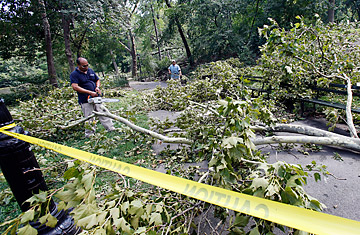
A park official prepares to cut up trees that were blown or struck down in New York's Central Park.
Of all the customary hazards of life in a big city, the threat of falling tree branches is not one. Yet on the warm afternoon of June 26, a limb snapped and plummeted 30 feet from a honey locust tree at the Central Park Zoo in New York City, striking Karla DelGallo, 33, and killing her infant daughter.
Raising New Yorkers' alarm, the accident marked the third of its kind in Central Park in less than a year. And in its immediate aftermath, city officials could not determine which agency was responsible.
Neither could they determine why the branch fell. In the two other accidents, the reasons had been clear. The branch that dislodged from a pin oak on the west side of the park in July 2009, severely injuring a young Google employee, was rotting. In February, when a limb broke off an American elm near a picturesque park walkway around East 69th St. and killed a 46-year-old Brooklyn man, it had been weighed down with heavy snow.
On Monday, city officials said that the limb that killed the 6-month-old girl on Saturday was healthy and had not appeared in any danger of falling. Mayor Michael Bloomberg said the accident was likely "an act of God" and that while tragic, such accidents could not be completely avoided.
"Only if you cut down every single tree in the city down to ground level can you guarantee that nothing's going to fall," the mayor said in a press conference. "Unfortunately, nature works that way."
Bill Logan, a private arborist who teaches pruning and tree identification at the New York Botanical Garden's School of Professional Horticulture, had inspected the honey locust at the zoo and declared it healthy. "It seemed to have an intact root system," Logan says. He adds that when assessing a tree's health, one looks for signs at the base of the tree that indicate whether it is capable of sustaining its branches. "You look for missing bark, lesions along the bark and fungi on the trunk for evidence of circulation problems. You make sure the tree can get nutrients up to the leaves where the business happens, where the fruit is made," he says.
Typically, in trees that are symptom-free, the threat of a branch breaking off on its own is low. But in some cases, a phenomenon called "sudden branch drop" may occur, in which heat and humidity cause a limb to spontaneously fall. "Limbs drop sometimes. That happens," says Bob Redman, a certified arborist who inspects and treats trees throughout the New York area. "It's pretty rare if you go back in time."
To help reduce the risk of freak accidents, the 25,000 trees in Central Park are regularly inspected and pruned — a responsibility that falls within the purview of the Central Park Conservancy, the private, nonprofit organization that accounts for most of the park's maintenance, operations and budget. The group's competence has been questioned following the recent accidents: two lawsuits are pending — one involving the Google employee injured in February, and the other filed by the family of the Brooklyn man who died last July. In the latter case, the conservancy is accused of being negligent for not having removed a tree that had been deemed dangerous two months earlier.
The rest of New York City's 5.2 million trees are maintained by the City Parks Department, which in 2009 responded to 8,500 reports of hanging limbs, removing dead or potentially dangerous portions of foliage. Each year the Parks Department routinely inspects the city's trees by community board district — in total, the urban forest numbers more than one tree for every two New Yorkers and covers one-quarter of the city's 305 square miles in canopy.
Those numbers are likely to grow, since Bloomberg announced in 2007 an effort to plant 1 million new trees in New York in 10 years, as part of an initiative to improve public health and the environment. Sixty percent of the trees to be planted along streets, parks and public spaces will be funded by the city, and the government is encouraging homeowners, corporations and nonprofits to plant the other 400,000 trees.
The hope is that plants and people can continue to peacefully co-exist. "It's amazing that trees are able to live in some of the places we make them live," Logan says. "But we make that happen. There are some streets where the trees are happy as clams."
